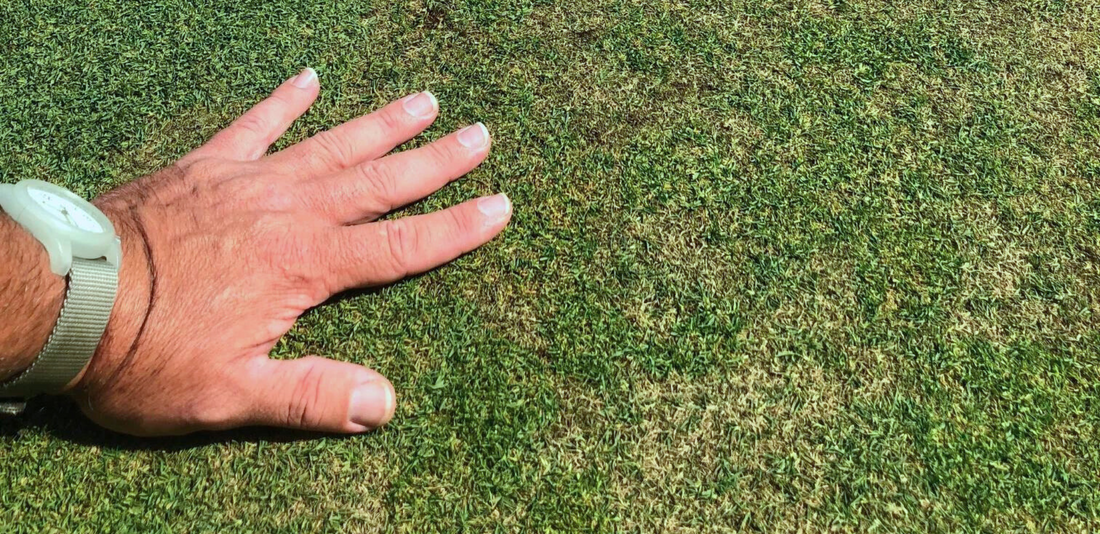
Pathogen Profile: Colletotrichum cereale (Anthracnose)
THis blog can be found in the new En-Turf website: https://www.enturf.com/post/pathogen-profile-colletotrichum-cereale-anthracnose
What is Anthracnose?
by Ellie Kim, BSc
Introduction
Anthracnose is a fungal disease caused by Colletotrichum cereale and is a common problem for golf courses, lawns, and other turfgrass areas. Anthracnose has been reported to affect 66% of golf courses in the United States and Canada, with outbreaks increasing in intensity and frequency. The economic cost of controlling anthracnose is estimated to be $20,000 annually per facility. Resistance to chemical fungicide treatments has increased the need to develop alternative methods of prevention and control [5,7].
Host Species:
- Creeping Bentgrass (Agrostis stolonifera)
- Annual Bluegrass (Poa annua)

Figure 1. Anthracnose in a turfgrass putting green. https://content.ces.ncsu.edu/anthracnose-in-turf
Symptoms
Anthracnose can develop as a foliar blight, in which the turfgrass leaves are infected, or a basal rot, which attacks the leaf sheaths, crowns, and stolons of the plant. Foliar blight is characterized by irregularly shaped patches of yellow-orange turf, ranging in size from a few inches to several feet. The severity of symptoms is typically highest in areas that are stressed due to low mowing, excessive traffic, or inadequate irrigation or fertilization. On individual plants, symptoms will first appear on the older leaves and progress to the younger leaves. In the case of basal rot, the leaf sheaths, crowns, and stolons will turn dark and decay. The anthracnose pathogen generates spores within acervuli, which are black, saucer-shaped pads adorned with black spines (setae) [1,2,7].

Figure 2. Anthracnose disease of annual bluegrass displaying a circular patch with spore-bearing structures. Photo: James Hempfling.
https://gcmonline.com/course/environment/news/anthracnose-annual-bluegrass

Figure 3. Black rotting crowns, roots, and stem bases. https://www.apsnet.org/edcenter/disandpath/fungalasco/pdlessons/Pages/Anthracnoseofturfgrass.aspx
Life Cycle and Infection Stages
The causal fungus of anthracnose overwinters as dormant mycelium and resumes activity in the spring or summer. The infected turfgrass contains spores that can be carried or displaced to non-diseased plants via water or on turf equipment and shoes. If the conditions are conducive for spore germination, the fungus will penetrate the tissues and result in disease [6,7].

Figure 4. The life cycle of anthracnose in turfgrass typically involves the following stages: infection, colonization, sporulation, and dormancy. https://www.apsnet.org/edcenter/disandpath/fungalasco/pdlessons/Pages/Anthracnoseofturfgrass.aspx
Growth Conditions
Anthracnose can occur during periods of cool temperatures in the spring and warm, humid weather in the summer. Climatic conditions are optimal between 70℉ and 82℉; however, the disease often occurs at temperatures significantly higher or lower than this range. Physiological stress significantly encourages the development and spread of the disease. In golf course putting greens, the most common culprits are close mowing, drought stress, low fertility, excessive traffic, poor soil drainage, or excessive thatch/organic matter accumulations [3,4,6].
Methods of Prevention and Control
To effectively manage anthracnose in turfgrass, it is important to implement the following prevention and control measures [2,5,7].- Cultural Management: Turfgrass is more susceptible to Colletotrichum cereale when it is exposed to stressors such as high temperatures, root zone compaction, thatch buildup, low fertility, drought, low mowing height, and insect infestations. Alleviating these stressors can help to reduce the incidence and severity of anthracnose. These practices may involve aerification, dethatching, topdressing, using lightweight equipment for mowing, increasing nitrogen fertilization, and ensuring sufficient irrigation to prevent drought stress.
- Chemical Management: Several contact (e.g. chlorothalonil), penetrant (such as trifloxystrobin), and systemic (e.g. propiconazole) fungicides are registered for control of anthracnose. While all of these fungicides can offer preventive control before infection, only penetrant and systemic fungicides can provide curative control after infection has occurred. However, it is important to note that the anthracnose-causing pathogen can become resistant to certain fungicides very quickly. Resistance to benzimidazole fungicides (e.g. thiophanate methyl), Qol fungicides (e.g. azoxystrobin, trifloxystrobin, and pyraclostrobin), and demethylation-inhibitor fungicides (DMIs) have already been shown.
- Biological Control: Research studies performed by Jim Baird at the University of California Riverside demonstrated that microbial inoculants are effective in the prevention and control of anthracnose in turfgrasses. This is due to the introduction of beneficial microorganisms with known adverse effects on the pathogen. Specifically, microbial inoculants aid in promoting stress tolerance, improving soil health, and facilitating nutrient uptake for enhanced plant growth.

Figure 5. Microbial inoculants at the University of California, Riverside Anthracnose Trial (2022). Left image (control): anthracnose infected turf with no additive. Right image (treated): anthracnose infected turf with microbial inoculants. Source: Earth Microbial
Conclusion
Anthracnose is a fungal pathogen with devastating effects on turfgrass. The substantial economic burden of anthracnose makes prevention and control of the disease very important. The emerging resistance to chemical fungicides increases the urgency for alternative treatments. Microbial inoculants are an alternative treatment that promotes disease resistance and reduces the reliance on chemical fungicides.
References:
- Butler, L., & Kerns, J. (2017). Anthracnose in turf: NC state extension publications. Retrieved from https://content.ces.ncsu.edu/anthracnose-in-turfhttps://content.ces.ncsu.edu/anthracnose-in-turf
- Crouch, J. A., & Clarke, B. B. (2012). Biology and pathology of turfgrass anthracnose. USDA ARS. Retrieved from https://www.ars.usda.gov/ARSUserFiles/12753900/TurfgrassAnthracnose.pdf
- Fresenberg, B.,Tisserat, N.,Corwin, B. (2022). Identification and Management of Turfgrass Diseases. Extension.missouri.edu. Retrieved from https://extension.missouri.edu/publications/ipm1029?p=1
- Murphy, J.A., B.B. Clarke, C.J. Schmid et al. (2011). Development of best management practices for anthracnose disease on annual bluegrass putting green turf. In: 2011 USGA Turfgrass and Environmental Research Summary. USGA Turfgrass and Environmental Research Online 10(23):2.http://turf.lib.msu.edu/ressum/2011/2.pdf
- Inguagiato, J. (2016). Management of Annual Bluegrass on Golf Courses: Improved Practices for Maintenance, Pest Control, and Viable Techniques for Transition to More Desirable Grasses - UNIV OF CONNECTICUT. Portal.nifa.usda.gov. https://portal.nifa.usda.gov/web/crisprojectpages/0226385-management-of-annual-bluegrass-on-golf-courses-improved-practices-for-maintenance-pest-control-and-viable-techniques-for-transition-to-more-desirable-grasses.html
- Landschoot, P. (2021). Turfgrass diseases: Anthracnose (causal fungus: Colletotrichum cereale). Penn State Extension. Retrieved from https://extension.psu.edu/turfgrass-diseases-anthracnose-causal-fungus-colletotrichum-cereale#:~:text=Anthracnose%20can%20occurred%20during%20 periods,or%20higher%20than%20this%20range.
- Settle, D. M., & Martinez-Espinoza, A. D. (2006). Anthracnose of turfgrass. Anthracnose of turfgrass. Retrieved from https://www.apsnet.org/edcenter/disandpath/fungalasco/pdlessons/Pages/Anthracnoseofturfgrass.aspx
Header image from https://turfresearch.medium.com/pest-alert-6-anthracnose-191a39d853c

